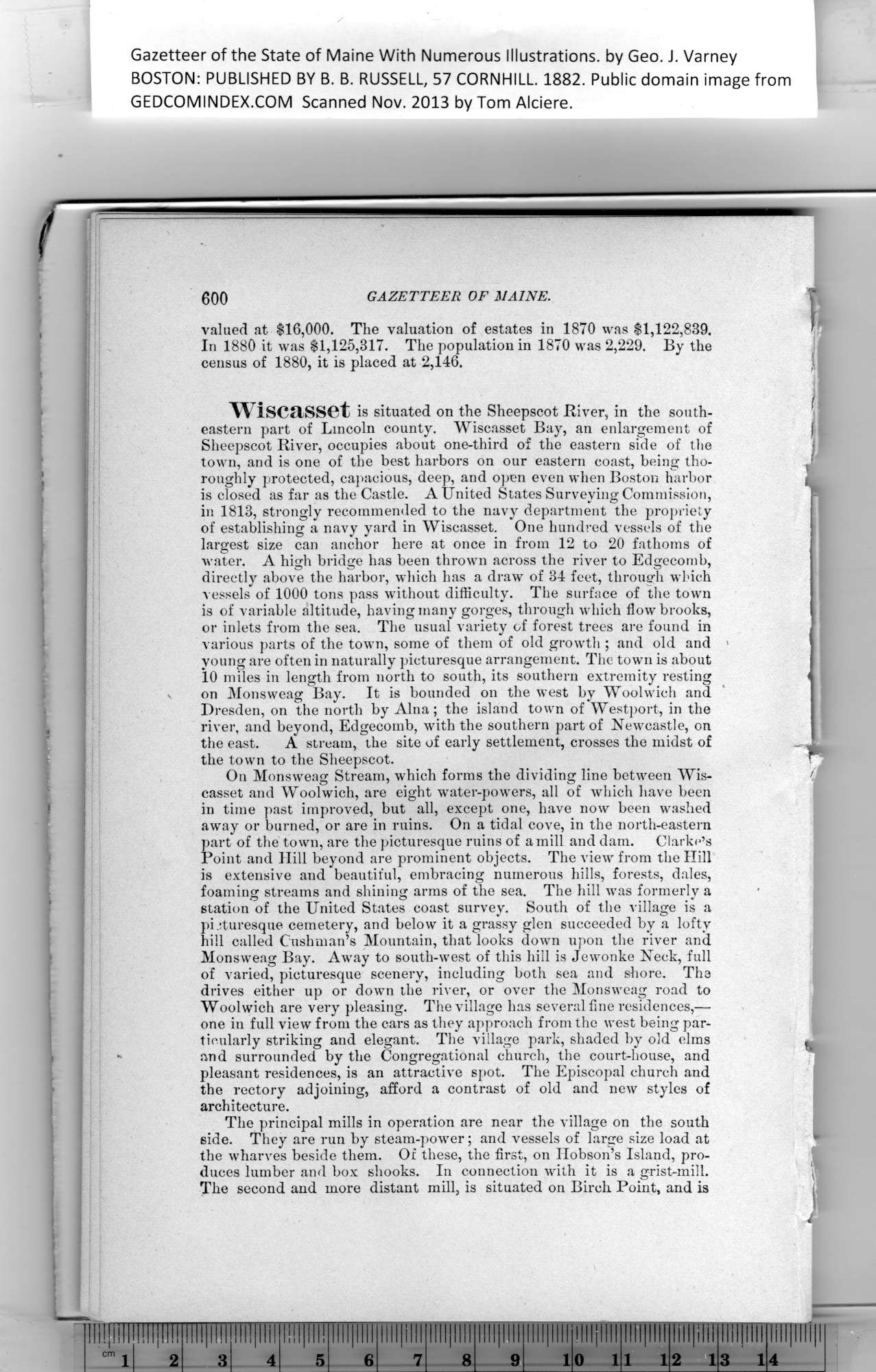|
Gazetteer of the State of Maine With Numerous Illustrations, by Geo. J. Varney
BOSTON: PUBLISHED BY B. B. RUSSELL, 57 CORNHILL. 1882. Public domain image from
600 GAZETTEER OF MAINE.
valued at $16,000. The valuation of estates in 1870 was $1,122,839.
In 1880 it was $1,125,317. The population in 1870 was 2,229. By the
census of 1880, it is placed at 2,146.
Wiscasset is situated on the Sheepscot River, in the south-
eastern part of Lincoln county. Wiscasset Bay, an enlargement of
Sheepscot River, occupies about one-third of the eastern side of the
town, and is one of the best harbors on our eastern coast, being tho-
roughly protected, capacious, deep, and open even when Boston harbor
is closed as far as the Castle. A United States Surveying Commission,
in 1813, strongly recommended to the navy department the propriety
of establishing a navy yard in Wiscasset. One hundred vessels of the
largest size can anchor here at once in from 12 to 20 fathoms of
water. A high bridge has been thrown across the river to Edgecomb,
directly above the harbor, which has a draw of 34 feet, through which
vessels of 1000 tons pass without difficulty. The surface of the town
is of variable altitude, having many gorges, through which flow brooks,
or inlets from the sea. The usual variety of forest trees are found in
various parts of the town, some of them of old growth ; and old and >
young are often in naturally picturesque arrangement. The town is about
10 miles iu length from north to south, its southern extremity resting
on Monsweag Bay. It is bounded on the west by Woolwich and
Dresden, on the north by Aina; the island town of Westport, in the
river, and beyond, Edgecomb, with the southern part of Newcastle, on
the east. A stream, the site of early settlement, crosses the midst of
the town to the Sheepscot.
On Monsweag Stream, which forms the dividing line between Wis-
casset and Woolwich, are eight water-powers, all of which have been
in time past improved, but all, except one, have now been washed
away or burned, or are in ruins. On a tidal cove, in the north-eastern
part of the town, are the picturesque ruins of a mill and dam. Clarke’s
Point and Hill beyond are prominent objects. The view from the Hill
is extensive and beautiful, embracing numerous hills, forests, dales,
foaming streams and shining arms of the sea. The hill was formerly a
station of the United States coast survey. South of the village is a
picturesque cemetery, and below it a grassy glen succeeded by a lofty
hill called Cushman’s Mountain, that looks down upon the river and
Monsweag Bay. Away to south-west of this hill is Jewonke Neck, full
of varied, picturesque scenery, including both sea and shore. The
drives either up or down the river, or over the Monsweag road to
Woolwich are very pleasing. The village has several fine residences,—
one in full view from the cars as they approach from the west being par-
ticularly striking and elegant. The village park, shaded by old elms
and surrounded by the Congregational church, the court-house, and
pleasant residences, is an attractive spot. The Episcopal church and
the rectory adjoining, afford a contrast of old and new styles of
architecture.
The principal mills in operation are near the village on the south
side. They are run by steam-power; and vessels of large size load at
the wharves beside them. Of these, the first, on Ilobson’s Island, pro-
duces lumber and box shooks. In connection with it is a grist-mill.
The second and more distant mill, is situated on Birch Point, and is
PREVIOUS PAGE ... NEXT PAGE
This page was written in HTML using a program written in Python 3.2
|
